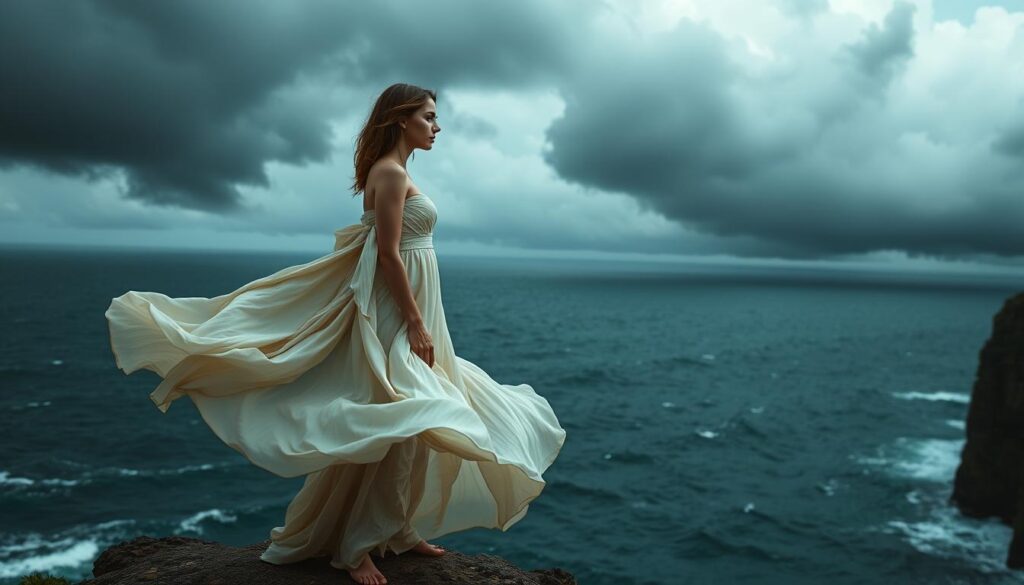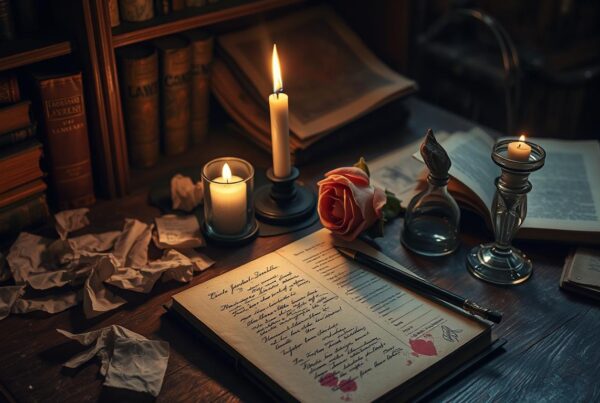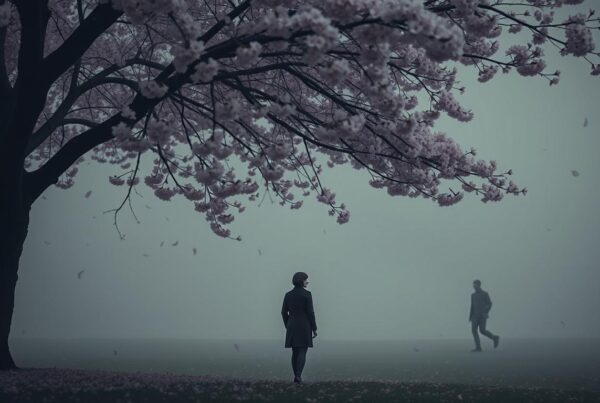For centuries, stories of women with unrequited love have moved us deeply. These tales of tragic love show the depth of female heroism in literature. They span from ancient myths to today’s novels, revealing the human heart’s complexities.
Unreturned love is a universal theme that touches us all. The tragic heroine is both vulnerable and strong. She shows us the power of love, even when it’s not returned. Exploring these stories, we gain insights into love and the forces that shape these noble figures.
Understanding the Tragic Heroine Archetype
The tragic heroine archetype has deeply influenced stories across many genres and cultures. These women are known for their deep love and strong moral values. They often have traits that make them stand out in literature.
A key part of the tragic heroine is their fatal flaw. This flaw always leads to their downfall. It’s a big part of their story.
Looking at these archetypes in literature shows us patterns. Their flaws and virtues make them very human and relatable. Their stories are deep reflections on human feelings and moral choices.
Studying these archetypes over time and in different places helps us see why they’re so important in stories. Understanding the tragic heroine means seeing the balance between their good qualities and their fatal flaw.
Historical Perspectives on Unrequited Love
Unrequited love has been a part of history for ages. It shows us the deep emotions and rules of society. Looking at mythological heroines and stories of unreturned love gives us a peek into our past.
Ancient Myths and Legends
Ancient myths and legends are full of stories about love and loss. Echo, a Greek nymph, loved Narcissus but he didn’t love her back. These stories teach us about love and loss from different cultures.
Medieval and Renaissance Literature
In the Middle Ages and Renaissance, stories of unrequited love were common. Courtly love was about knights loving ladies they could never have. This idea changed literature, like Dante Alighieri’s “La Vita Nuova” and his love for Beatrice.
Romantic Era Tragic Heroines
The Romantic Era changed how tragic heroines were seen. This time made literature more emotional, with stories of deep love and loss. Characters like Elizabeth from “Frankenstein” and Werther from “The Sorrows of Young Werther” showed the era’s love for intense stories.
Famous Examples of Tragic Heroines in Literature
We find many tragic heroines in literature who have made a big impact. These characters show us unrequited love and the world around them. They reflect the society and culture of their times.
Shakespeare’s Ophelia
Ophelia from Shakespeare’s “Hamlet” is a very sad character. She shows us what happens when love is not returned. Her story of madness and death is very moving.
Shakespeare’s Ophelia is a famous character. Her story still touches people’s hearts today.
Dante’s Beatrice
Beatrice from “The Divine Comedy” is a symbol of love and beauty. She was a brief but big part of Dante’s life. Her influence on his work is huge.
Beatrice is a beloved character in literature. Her story of love and guidance to Dante is unforgettable.
Tolstoy’s Anna Karenina
Anna Karenina from Leo Tolstoy’s novel is a classic tragic heroine. She faced tough choices between love and society. Her story shows the dangers of forbidden love.
Anna Karenina is a key figure in literature. Her tale of love and societal pressure still speaks to us today.
The Psychological Impact of Unrequited Love
Unrequited love can make you feel a lot of strong emotions. These feelings can hurt your mental health a lot. You might feel anxious, depressed, and doubt yourself a lot.
Starting with hope and longing, unrequited love can turn into grief. You might go through denial, anger, bargaining, depression, and then acceptance. These feelings can really hurt your well-being.
Learning about love psychology helps you deal with unreciprocated feelings. Talking to friends, taking care of yourself, and seeing a therapist can help. These steps can ease your pain.
Studies show that unrequited love can hurt you for a long time. But, it can also help you grow and understand yourself better. By facing these feelings, you can become stronger and more resilient.
The Tragic Heroine: Women Who Love Without Return
Heroines in tragedy, who love and sacrifice without getting anything back, still grab our attention today. These women show deep emotions and teach us about being strong and understanding.

Looking into the lives of tragic heroines, like Ophelia from Shakespeare and Anna Karenina from Tolstoy, shows us their big struggles. They make sacrifices for love that doesn’t come back. Today’s movies and books also tell stories of women facing love and loss.
These tragic heroines have always been fascinating. Their stories touch us, showing the lasting power of love and sacrifice. Through their tales, we see the deep strength and vulnerability of women in tragic stories.
The Role of Society in Shaping Tragic Heroines
The tragic heroine is a complex character. She is shaped by society’s views on literature. Historical and cultural settings have greatly influenced these characters.
By looking at how society sees gender in stories, we understand tragic heroines better. This shows how societal views add to their complexity.
Societal Expectations and Gender Roles
Societal expectations have always guided literary heroines. From ancient times to today, gender roles in stories have shaped their choices and fates. The tragic path of a heroine often follows societal norms.
These norms ask for selflessness, loyalty, and personal sacrifice. This shows how deeply society influences literature.
Cultural Depictions of Female Sacrifice
The idea of female sacrifice is key in many tragic stories. Cultural views have long celebrated women’s suffering and endurance. This makes women seem destined to face emotional and physical hardships.
This sacrifice is a key part of a tragic heroine’s story. It highlights how deeply society shapes literature.
Modern Interpretations of the Tragic Heroine
In today’s stories, the tragic heroine is still a strong figure. But now, she’s more complex and real. She shows the struggles of our time in books and movies.
Contemporary Literature and Cinema
Stories today have changed the tragic heroine. They make her more than just a character. Women like Katniss Everdeen and Elizabeth Bennet face tough choices and love.
These women deal with their own fears and the world’s problems. Their stories connect with us today.
Reimagining the Tragic Heroine in Modern Contexts
Now, stories put tragic heroines in our world. For example, Jo March in “Little Women” by Greta Gerwig. She fights for her dreams and happiness.
This new take on tragic heroines gives them power. It shows their journey from pain to finding strength.
Comparisons Between Male and Female Tragic Figures
Looking at tragedy, we see how male and female characters are shown differently. Female tragic figures are often seen as emotionally driven. Their stories are filled with love, sacrifice, and unreturned feelings. Male tragic figures, on the other hand, are about power, ambition, and falling from grace.
Gender roles shape how these characters are seen. Female characters like Ophelia or Anna Karenina show what women were expected to be. They highlight emotional depth and the pressures women faced. Male figures, like Oedipus or Hamlet, deal with fate, identity, and big questions about life.
These differences tell us a lot about gender in tragedy. Male and female tragic characters are more than just stories. They show us old and new views on gender roles. Female figures make us feel for them because of their vulnerability. Male figures get our respect or pity because of their grand struggles and complex morals.
In short, the way male and female tragic figures are shown shows us what society expected back then. By looking at these differences, we learn more about how tragedy reflects and challenges our views on gender.
Case Studies: Real Women with Stories of Heartbreak
Many women in history have shown great strength and courage. Their stories help us understand the challenges they faced. These women’s lives show us their bravery and resilience.
Marie Antoinette
Marie Antoinette was the last Queen of France before the French Revolution. She was known for her luxury and tragic end. Her life was filled with love and betrayal, making her a famous tragic heroine.
Frida Kahlo
Frida Kahlo was a Mexican artist known for her art and tough life. Her love with Diego Rivera was full of passion and pain. Her art showed her deep emotions, making her a powerful tragic heroine.
Princess Diana
Princess Diana was loved by many for her kindness and grace. Her marriage was hard, filled with unfulfilled love. Her honesty about her struggles made her a beloved figure among heartbroken women in history.
The Symbolism of the Tragic Heroine in Art
The tragic heroine has inspired many in art, showing deep emotions and society’s themes. Looking at visual art, sculpture, theater, and ballet, we see how these figures still touch us.
Visual Art and Sculpture
Visual art shows the tragic heroine’s essence with powerful images and feelings. Artists like John William Waterhouse painted figures like Ophelia. They let us see the heroines’ emotional battles and unmet dreams.
Sculpture also keeps these figures alive with detailed realism. Auguste Rodin’s works, for example, show deep emotions. They capture the heroine’s inner fight and strength.
Theater and Ballet
The stage brings tragic heroines to life, mixing performance, sets, and costumes. Shakespeare’s Juliet or Tennessee Williams’ Blanche DuBois show the heroine’s complex life. They draw us in with strong stories and acting.
Ballet also tells these stories beautifully. “Giselle” and “Swan Lake” use dance to show the heroine’s pain and courage. Dance makes their feelings reach us in a special way.
The Lifelong Journey of the Tragic Heroine
Tragic heroines in literature take us on a deep journey. They capture our hearts with their complex stories and growth. Their tales are filled with big challenges, showing us the power of love that’s not returned.
At the start, these heroines face many personal struggles. These struggles shape who they are and how strong they become. As they deal with love that’s not returned, their stories become more real and touching.
Their stories show how they grow and change. These changes highlight their growth and the impact of their experiences. Each part of their story shows how they learn and grow, often leading to deep insights or touching conclusions.
Tragic heroines have captured hearts for many years. Their stories reflect our own struggles and the search for meaning in hard times. This connection makes them timeless in literature, showing both our weakness and strength.
The journey of the tragic heroine shows the lasting power of stories. Her struggles and changes teach us about love, loss, and the human spirit. These lessons make her stories continue to inspire and touch people all over the world.
The Cultural Legacy of the Tragic Heroine
The tragic heroine has made a big mark on our culture. She is seen in literature, music, and the performing arts. Her stories of heartbreak and loss touch our hearts deeply.
Literary Influence
Tragic heroines have shaped many books, from Shakespeare’s “Hamlet” to today’s novels. Their tales of love, sacrifice, and pain show the lasting impact of the heroine. These stories help us see our own feelings in a new way.
Influence on Music and Performing Arts
Tragic heroines have also changed music and theater. Maria Callas’ Violetta in “La Traviata” and Giselle in ballet touch our souls. These performances show the power of art to connect us all.
Breaking Free from the Tragic Heroine Mold
In today’s stories and shows, a big change is happening. Creators are trying to change the idea of the tragic heroine. Now, heroines are more than just about unrequited love and suffering. They show a wide range of human experiences.
Modern heroines are strong, determined, and know themselves well. They move beyond old ideas, showing women’s power and choice. Characters like Katniss Everdeen from “The Hunger Games” and Moana from Disney’s movie are examples. They show how women can be in today’s stories.
Writers and directors are making heroines face challenges for growth, change, and power. Stories like “Hidden Figures” and “Wonder Woman” show heroines leading and inspiring. They give new ideas of strength and complexity in stories all over the world.
Expert Opinions on the Tragic Heroine Archetype
Psychologists and literary critics have studied the tragic heroine archetype a lot. They look into the emotional and mental sides of these characters. This helps us understand why they are so appealing and important.
Psychological Analysis
Experts say tragic heroines face deep emotional battles. They study how these characters deal with love, loss, and social pressures. This shows how unrequited love affects their mental health and makes their stories tragic.
Literary Criticism
Literary critics, including feminist ones, look at tragic heroines in books. They analyze their roles and how they are shown. This helps challenge old stories and push for more varied characters.
Lessons Learned from Stories of Unreturned Love
The tragic heroine archetype teaches us deep life lessons from literature. We see how they grow and find empowerment from heartbreak. These stories show us how to be strong when we face emotional pain.

Personal Growth and Empowerment
Characters like Jane Austen’s Anne Elliot in “Persuasion” grow through heartbreak. They become stronger and more aware of themselves. This shows how heartbreak can help us grow and change.
Understanding Emotional Resilience
Books like Charlotte Brontë’s “Jane Eyre” and Margaret Mitchell’s “Gone with the Wind” show emotional resilience stories. They teach us to keep going through tough times. They show that staying hopeful and determined helps us build resilience.
A Glimpse into the Future for the Tragic Heroine
The tragic heroine is at a key moment in literature and media. The future will see big changes in how we show unrequited love and sacrifice. As we learn more about gender roles, love in media will change too.
The tragic heroine will become more complex and strong. She will show both weakness and power. This change is already happening in books and movies.
These new tragic heroines face modern challenges and win. Their stories are not just about heartbreak. They are about finding themselves and growing strong.
This change fits with our culture’s focus on emotional strength and growth. The tragic heroine’s story will keep being important. But it will change to fit what society thinks now.
In the future, tragic heroines will be more than their sadness. They will show how to overcome it. This change makes the tragic heroine’s story relevant for years to come.



